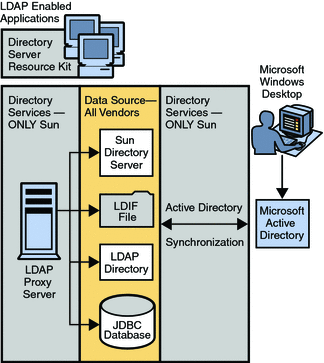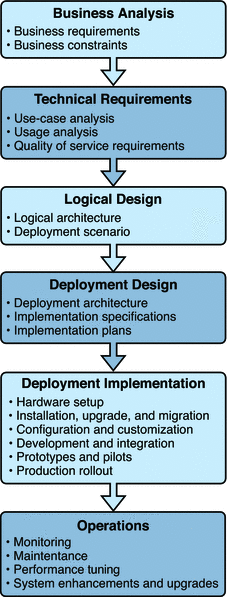Part I Overview of Deployment Planning for Directory Server Enterprise Edition
This part provides an introduction to Directory Server Enterprise Edition and explains the steps involved in planning a deployment (solution life cycle). It contains the following chapters:
-
Chapter 1, Introduction to Deployment Planning for Directory Server Enterprise Edition covers the deployment planning process.
-
Chapter 2, Business Analysis for Directory Server Enterprise Edition covers business requirements.
For more information about the deployment planning process, see the Sun Java Enterprise System Deployment Planning Guide.
Chapter 1 Introduction to Deployment Planning for Directory Server Enterprise Edition
This chapter provides an overview of Sun Directory Server Enterprise Edition, and describes at a high level the deployment planning process.
This chapter covers the following topics:
About Deployment Planning
Deployment planning is a critical step in the successful implementation of a Directory Server Enterprise Edition solution. Each enterprise has its own set of goals, requirements, and priorities to consider. Successful planning starts with analyzing the goals of an enterprise and determining the business requirements to meet those goals. The business requirements must then be converted into technical requirements. The technical requirements can be used as a basis for designing and implementing a system that meets the goals of the enterprise.
Successful deployment planning is the result of careful preparation, analysis, and design. Errors and missteps that occur anywhere during the planning process can result in a system that can be problematic in many ways. Significant problems can arise from a poorly planned system. For example, the system could under perform or be difficult to maintain, expensive to operate, or unable to scale.
The principles of deployment planning are discussed in depth in the Sun Java Enterprise System Deployment Planning Guide. This guide refers to the solution life cycle, which addresses deployment planning in clearly defined steps.
Directory Server Enterprise Edition Components in a Deployment
The combination of Directory Server Enterprise Edition components that you deploy depends on the requirements of your organization. The following figure shows a typical deployment scenario using the components described previously.
Figure 1–1 Directory Server Enterprise Edition Components

Solution Life Cycle
The solution life cycle shown in the following figure depicts the steps in the planning, design, and implementation of an enterprise software solution based on Java Enterprise System. The life cycle is a useful tool for keeping a deployment project on track. The solution life cycle is described in detail in the Sun Java Enterprise System Deployment Planning Guide.
Figure 1–2 Solution Life Cycle

Chapter 2 Business Analysis for Directory Server Enterprise Edition
During the business analysis phase of the solution life cycle, you define business goals by analyzing a business problem. You then identify the business requirements and business constraints to meet those goals.
This chapter contains the following sections:
About Business Analysis
Business analysis starts with stating business goals. You then analyze the business problems that you must solve and identify the business requirements that must be met to achieve the business goals. Consider any business constraints that limit your ability to achieve the goals. The analysis of business requirements and constraints results in a set of business requirements documents.
You use the resulting set of business requirements documents as a basis for deriving technical requirements in the technical requirements phase. Throughout the solution life cycle, you measure the success of your planning and of your solution according to the analysis performed in the business analysis phase.
Defining Directory Server Enterprise Edition Business Requirements
No simple formula exists to identify business requirements. Business requirements are determined based on collaboration with the stakeholders requiring an identity management solution, your own knowledge about the business domain, and applied creative thinking. The Sun Java Enterprise System Deployment Planning Guide describes the business analysis process in detail. It includes factors to consider when defining business requirements and constraints. This section outlines the business requirements that drive the need for a robust directory service.
Your enterprise requires a robust directory service in the following situations:
-
You must make critical business information and applications available to a constantly growing and changing user base.
-
These users include not only internal employees but external users such as customers, vendors, and other business partners.
A directory service addresses these needs by providing a highly available, scalable, manageable, integratable, and secure foundation for an effective identity management infrastructure. The service delivers a set of capabilities to provide a centralized data store for users' identity data and for supporting data for web services architectures.
By delivering an effective identity management infrastructure, the directory service addresses the key enterprise requirements associated with serving users and the applications that help users perform their jobs.
These requirements include the following:
-
Opening up access to large and constantly changing groups of users
-
Increasing security to ensure that information is properly used and shared, and that sensitive information is protected
-
Providing consistently reliable access and a high quality of service to users and applications
-
Delivering information and services to users efficiently, no matter how business needs change or user requirements grow
A high-performing directory service that is highly available, reliable, and secure addresses the primary business drivers : security, quality of service, and cost-efficiency.
- © 2010, Oracle Corporation and/or its affiliates
